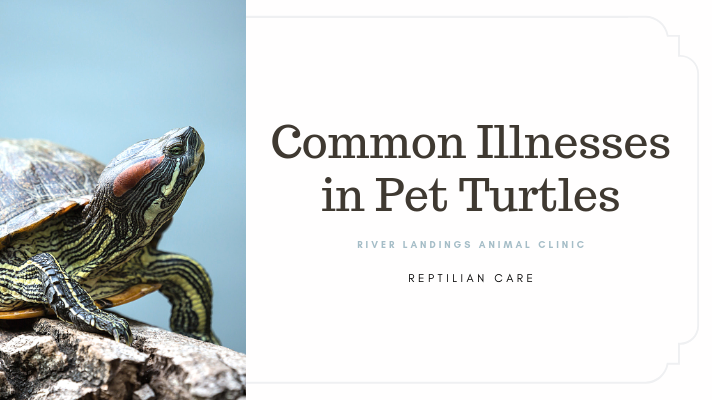What are some of the common diseases of pet turtles?
Common conditions of pet turtles include Vitamin A deficiency, respiratory diseases, abscesses, shell infections and fractures, and parasites.
What are the signs of these diseases?
Vitamin A deficiency occurs as a result of feeding turtles an inappropriate diet. The all-meat diet, or the "cricket and fruit cocktail" diet, or the "lettuce and carrots" diets are all deficient. Lack of Vitamin A produces signs seen with changes in the epidermis (outer layer of skin and mucus membranes), including lack of appetite, lethargy, swelling of the eyes and eyelids (often with a pus-type discharge), swelling of the ear (actually an ear abscess), and respiratory infections.
Most respiratory infections are caused by bacteria, and in turtles are often secondary to Vitamin A deficiency. Turtles with respiratory infections may have excess mucus in their oral cavities, nasal discharges, lethargy and loss of appetite, and possibly open-mouth breathing and wheezing.
Abscesses, commonly seen in pet turtles, appear as hard tumor-like swellings anywhere on the pet's body. Abscesses often are located on the opening of the ear in turtles. Abscesses in turtles are often related to Vitamin A deficiency.
Shell problems are often encountered in turtles. These can be infections caused by bacteria, fungi, or viruses, or more commonly are the result of fractures of the shells. Fractured shells can result from trauma from vehicles (being run over by a motor vehicle) or from dog bites (turtle housing should be constructed to prevent access from predators such as dogs.)
Parasites, such as roundworms, are common in pet turtles. They often cause no clinical signs and are detected on an annual fecal examination. They may, however, cause diarrhea or weight loss.
How can I tell if my turtle is sick?
Signs of disease in turtles may be specific for a certain disease, such as nasal discharge in the case of a respiratory infection, or non-specific, such as a turtle with anorexia (lack of appetite) and lethargy, which can be seen with many diseases. Any deviation from normal should be a cause for concern and requires immediate evaluation by your veterinarian.
How are turtle diseases treated?
Vitamin A deficiency is treated with either oral or injectable Vitamin A. Treatment should only be done under veterinary supervision, as hypervitaminosis A, a condition resulting from the incorrect usage and over-dosage of Vitamin A, can occur. Speak with your veterinarian on how to further prevent vitamin A deficiency.
Respiratory infections are most often caused by bacteria; many of these turtles also have Vitamin A deficiency that requires treatment as well. Your veterinarian may want to do radiographs (X-rays), blood tests, and cultures to determine the cause of the infection. Occasionally, allergies can cause nasal discharge as well. Treatment for true infections involves antibiotics given orally or as injections, and possibly nose drops. Sick turtles require intensive care, including fluid therapy and force feeding, in the hospital.
Abscesses are treated surgically; the abscess is opened and flushed with a medicated solution. A culture of the abscess may be needed to determine the type of infection that caused the abscess. Topical medication and injectable antibiotics may also be used.
Shell fractures can usually be repaired by your veterinarian. Severe shell fractures may not be able to be repaired. Infections are more difficult to treat but usually involve identifying what type of organism (virus, bacterium, or fungus) is causing the problem, thoroughly cleaning the shell, and using appropriate anti-microbial therapy.
Parasites are treated with the appropriate deworming medication. The type of parasite identified on the microscopic fecal examination will determine which drug is needed.
Any disease in turtles can be severe enough to cause a loss of appetite and lethargy. When seen, these signs indicate a guarded prognosis and the need for hospitalization and intensive care, which can include fluid therapy and force-feeding.
Hear From Us Again
Don't forget to subscribe to our email newsletter for more recipes, articles, and clinic updates delivered to your inbox (here). Or, you can keep up to date by liking and following our Facebook page (here).
Related: We have more information under our small animal care categories.

